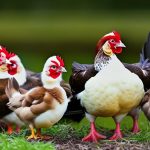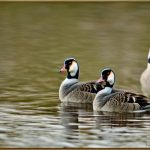Geese breeding season typically occurs in the spring, with nesting and egg-laying taking place between March and May. During this time, geese become more territorial and protective of their nesting areas, which can lead to conflicts with humans. Understanding the behavior and needs of geese during the breeding season is crucial for effectively managing their presence in urban and suburban areas.
Geese are monogamous birds and will return to the same nesting site year after year. They prefer nesting near water, such as ponds, lakes, or rivers, where they can find food and protection for their young. During the breeding season, geese become more aggressive and vocal, especially when they feel threatened or perceive a potential threat to their nests or goslings. It is important to be aware of these behaviors and take proactive measures to minimize conflicts and ensure the safety of both geese and humans.
Providing Suitable Nesting Areas
One of the key strategies for managing geese during the breeding season is to provide suitable nesting areas that can help minimize conflicts with humans. Creating designated nesting sites with appropriate vegetation and protection can help encourage geese to nest in specific areas, away from high-traffic areas and human disturbances. This can be achieved by establishing nesting islands or platforms in bodies of water, where geese can safely build their nests and raise their young without interference.
In addition to providing nesting areas, it is important to monitor and manage these sites to ensure they remain suitable for geese throughout the breeding season. This may involve regular maintenance of vegetation, removal of predators, and protection from human disturbances. By creating and maintaining suitable nesting areas, communities can help mitigate conflicts with geese and promote coexistence in urban and suburban environments.
Implementing Vegetation Management
Vegetation management plays a crucial role in managing geese during the breeding season. Geese rely on vegetation for nesting materials, food, and protection for their young. By implementing vegetation management strategies, communities can help create a balance that meets the needs of geese while minimizing their impact on public spaces.
One effective approach is to establish buffer zones of tall grasses and shrubs around bodies of water, which can provide geese with suitable nesting materials and cover while also creating a natural barrier to human activity. This can help discourage geese from nesting in high-traffic areas and reduce conflicts with humans. Additionally, regular maintenance of vegetation can help prevent overgrowth and create a more open and visible environment, which can deter geese from nesting in certain areas.
Minimizing Human Disturbance
During the geese breeding season, it is important to minimize human disturbance to reduce conflicts and ensure the safety of both geese and humans. Human activities such as loud noises, approaching nesting areas, and allowing pets to roam freely can disrupt geese and lead to aggressive behavior. By educating the community about the importance of minimizing human disturbance during the breeding season, communities can help create a more harmonious coexistence with geese.
One effective way to minimize human disturbance is to establish clear signage and designated areas where geese are known to nest. This can help raise awareness among residents and visitors about the presence of nesting geese and the need to avoid these areas during the breeding season. Additionally, enforcing leash laws for pets and implementing restrictions on certain activities near nesting sites can help reduce human disturbance and promote a safer environment for geese and their young.
Installing Fencing and Barriers
Installing fencing and barriers can be an effective strategy for managing geese during the breeding season. By creating physical barriers around nesting areas, communities can help prevent geese from accessing high-traffic areas and reduce conflicts with humans. This can also help protect geese and their young from potential threats and disturbances.
One approach is to install low fencing or barriers around bodies of water and designated nesting sites to create a clear boundary that discourages geese from venturing into public spaces. This can help redirect geese to more suitable nesting areas and minimize their impact on urban and suburban environments. Additionally, installing barriers such as floating islands or platforms in bodies of water can provide geese with safe and secluded nesting areas, away from human disturbances.
Managing Water Features
Managing water features is essential for effectively managing geese during the breeding season. Geese are attracted to bodies of water for nesting, feeding, and protection for their young. By implementing water management strategies, communities can help create a more balanced environment that meets the needs of geese while minimizing their impact on public spaces.
One effective approach is to implement water quality management practices that can help discourage geese from congregating in certain areas. This may involve using natural deterrents such as water fountains, aeration systems, or water additives that can make the environment less attractive to geese. Additionally, regular maintenance of water features, such as removing algae and debris, can help create a less hospitable environment for geese and reduce their presence in urban and suburban areas.
Using Visual Deterrents
Using visual deterrents can be an effective strategy for managing geese during the breeding season. Visual deterrents can help create a more hostile environment for geese and discourage them from nesting in high-traffic areas. By implementing visual deterrents, communities can help minimize conflicts with geese and promote a safer and more harmonious coexistence in urban and suburban environments.
One approach is to use decoys, such as predator models or silhouette cutouts, to create the illusion of potential threats to geese. Placing these visual deterrents near nesting areas and high-traffic locations can help deter geese from nesting in these areas and redirect them to more suitable locations. Additionally, using reflective tape, flags, or other visual stimuli can help create a more dynamic and unpredictable environment that can discourage geese from becoming too comfortable in certain areas.
Offering Alternative Feeding Areas
Offering alternative feeding areas can help minimize conflicts with geese during the breeding season. Geese are attracted to areas with abundant food sources, which can lead to overgrazing and conflicts with humans. By providing alternative feeding areas, communities can help create a more balanced environment that meets the needs of geese while minimizing their impact on public spaces.
One effective approach is to establish designated feeding areas with suitable vegetation and food sources that can attract geese away from high-traffic locations. This can help reduce overgrazing and conflicts with humans while also providing geese with the resources they need to thrive during the breeding season. Additionally, implementing feeding restrictions in certain areas and providing education to the community about the importance of offering alternative feeding areas can help promote a more harmonious coexistence with geese.
Educating the Community
Educating the community about geese behavior and the importance of coexisting with them during the breeding season is crucial for effective management. By raising awareness and providing information about geese behavior, needs, and potential conflicts, communities can help promote a more informed and proactive approach to managing geese in urban and suburban environments.
One approach is to provide educational materials, such as brochures, signage, and online resources, that can help residents and visitors understand the behavior and needs of geese during the breeding season. This can help raise awareness about the importance of minimizing human disturbance, providing suitable nesting areas, and implementing effective management strategies. Additionally, organizing community events, workshops, and outreach programs can help engage the public and promote a more collaborative and informed approach to managing geese in urban and suburban areas.
Seeking Professional Assistance
Seeking professional assistance can be beneficial for communities looking to effectively manage geese during the breeding season. Professional wildlife management experts and organizations can provide valuable insights, resources, and support for implementing effective management strategies and promoting a more harmonious coexistence with geese.
One approach is to consult with wildlife management professionals who can provide guidance and assistance in developing and implementing geese management plans. These experts can offer valuable expertise in understanding geese behavior, identifying suitable nesting areas, and implementing effective management strategies. Additionally, partnering with local wildlife organizations and agencies can help communities access resources, funding, and support for managing geese in urban and suburban environments.
In conclusion, effectively managing geese during the breeding season requires a proactive and collaborative approach that meets the needs of geese while minimizing their impact on public spaces. By understanding geese behavior, providing suitable nesting areas, implementing vegetation management, minimizing human disturbance, installing fencing and barriers, managing water features, using visual deterrents, offering alternative feeding areas, educating the community, and seeking professional assistance, communities can promote a more harmonious coexistence with geese in urban and suburban environments. With proactive management strategies and a commitment to coexistence, communities can create a safer and more balanced environment for both geese and humans during the breeding season.
Meet Walter, the feathered-friend fanatic of Florida! Nestled in the sunshine state, Walter struts through life with his feathered companions, clucking his way to happiness. With a coop that’s fancier than a five-star hotel, he’s the Don Juan of the chicken world. When he’s not teaching his hens to do the cha-cha, you’ll find him in a heated debate with his prized rooster, Sir Clucks-a-Lot. Walter’s poultry passion is no yolk; he’s the sunny-side-up guy you never knew you needed in your flock of friends!







